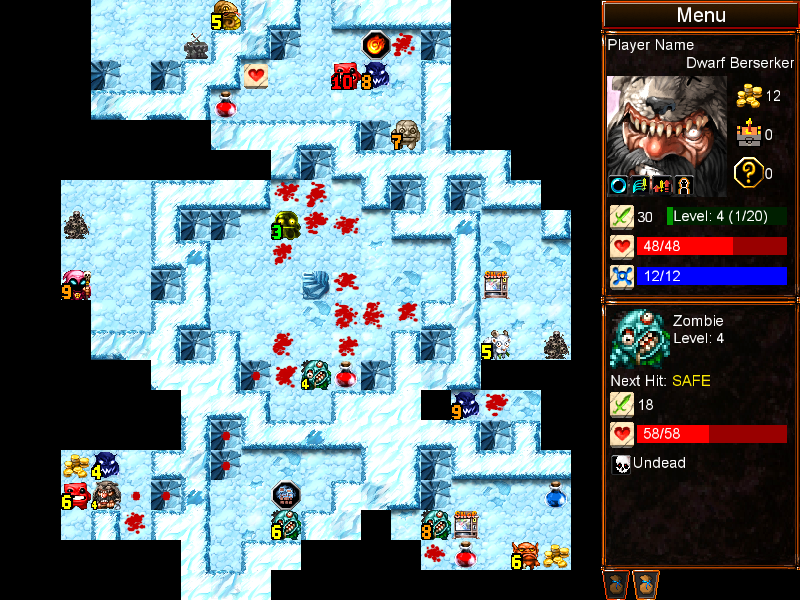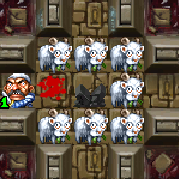Editor’s Note: Wrath.O.Tron is looking to be a new bot here at Big Shiny Robot! and wants to come at us with a weekly Sunday column called “The Blue Key.” Here’s his first contribution. And I have to say, after I read this column, I went and downloaded the free alpha of Desktop Dungeons and will be purchasing the beta with no hesitation. –Swankmotron
Alright folks, here’s the rundown: Desktop Dungeons is an indie roguelike with an average session length between ten and forty-five minutes depending on your play style and the difficulty level of your current dungeon. Despite being a self-described “coffee break game” with such a short session time, it remains true to its roguelike roots. The alpha prototype build won the “Excellence in Design” award at the 2011 IGF awards, and also made Gamasutra’s top ten indie games of 2010, and for good reason.
That alpha prototype is free to play, and will remain free forever and ever. (Note: The rest of this column concerns the newer, beta version of the game.)
After all this praise rained down upon them, the small South African development team (the awesomely named Quarter-Circle Forward) deconstructed the whole game and started rebuilding it from scratch in Unity. If you like the free alpha version, you can gain access to the latest beta build right away with a pre-order of just 10USD. (There’s also a “Special Edition” for 20USD.) Since you access the beta through Unity’s in-browser player, you unfortunately have to be connected to the internet to play it. On the other hand, your stashed equipment and progress through the persistent upgrade system are cloud-synced.
Be forewarned: there’s a good chance you’re going to die—and a lot—before you figure out how the game ticks. Procedural dungeon generation means that every dungeon run is going to play out a little differently. You have to make careful use of very scarce resources if you’re going to survive the inevitable boss fight. The development team once said they didn’t want to give the player any easy decisions. There are potions, equipment, and spells to make use of, but you also have to ration the actual exploration of each dungeon. Tiles are revealed when the character steps into an adjacent square, and each revealed tile heals your health and mana—the amount depends on your class and level. The catch is, they also heal the monsters that populate the dungeon, so in most cases you have to beat a monster in a single engagement. (Unless you’re getting tricky, which you should be.)
Speaking of monster beatdowns, at present there are over fifteen classes, and every one has an entirely unique playstyle. It’s actually pretty remarkable how differentiated the classes are while still feeling well-balanced. Throw different race bonuses and various god-worship boons into the mix and things get really complex. Spells and stat-boosters are randomly dispersed through each dungeon, which forces you to be resourceful and adaptable—sometimes a wizard’s just gotta beat down a goblin without the help of a trusty BURNDAYRAZ (fireball) spell.
If the name of the above-mentioned fireball spell is any indication—and it is—you can see that the game doesn’t take itself too seriously. The writing is full of genuinely entertaining absurdity, and the game’s artistic aesthetic plays into the cartoonish atmosphere. Watch out for the fearsome Goats. If you’re an indie game fan, you should also catch more than a couple references to other great indie games from recent years, the most prominent being the “Meat Man” monster. The art, by the way, is crazy stylistic and downright charming, and every race/class combination rocks a unique character portrait. These portraits and other visual design concepts are mostly the product of a shadowy figure known only as “Lurk.”
Sticking to its roguelike roots, the game is brutal and unforgiving. In harder difficulty dungeons, that means if you don’t play conservatively you’ll probably end up retreating with an empty swag bag. And nobody likes an empty swag bag.
A single dungeon crawl is fun, but what will keep you coming back is the persistent Kingdom system. The Kingdom is basically the game’s menu, it’s a sort of meta-game where you can stash useful items for later dungeons, upgrade buildings to unlock new classes and races, and later on you can even affect the layout of your next dungeon by adding extra shops, or more gold piles for example. A more dramatic example is the “Smuggler’s Den,” it snags a bunch of low level monsters and stat-boosters from around the dungeon and sticks them in a sub-dungeon right near your spawn point. Handy.
If all of this is still not enough for you—you spoiled jerk, you—as you progress through the game’s quests, you also unlock puzzle dungeons. These are non-procedural, preset dungeons where you must solve, you guessed it: puzzles. These are fun, challenging, and act as a palate cleanser besides being a nice, occasional change of pace.
I highly recommend checking out the alpha prototype, all you have to lose is a few minutes of your life—and if we’re being honest here, we all waste plenty of life-minutes on the internet every day, so it’s hardly a sacrifice. If you like it, the measly $10 investment is nothing compared to the hours of entertainment you’ll get out of Desktop Dungeons.
(About the author: Connor Cleary is a video game columnist and critic, a freelance web and graphic designer, and an aspiring fiction writer. He is a reviewer at GameShark and an occasional opinion and analysis columnist at Gamasutra. His writing archive is The Blue Key and his freelance design business is Four Stair Multimedia and Design.)




